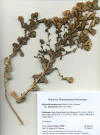|
Hazardia squarrosus
var. grindelioides |
Hazardia squarrosus
var. grindelioides |
|
Trees and Shrubs of Kern County (Sep 2012) Key to Hazardia 1. Subshrub, woody parts mostly root; Sierra Nevada....................... Hazardia whitneyi 1. Shrub—woody above base; west of the Sierra Nevada............................................ 2
2. Leaves 7–12 mm
wide; involucral bracts long narrow and tapered
2. Leaves 10–20 mm
wide; involucral bracts broad elliptical or widest
Hazardia squarrosa (Hooker & Arnott 1833) Greene 1894 var. obtusa (Hazardia obtusa Greene 1897) Jepson 1925 [Haplopappus squarrosus Hooker & Arnott 1833 ssp. obtusus (Greene) H. M. Hall 1928]. Sawtooth goldenbush. Subshrub or shrub to 2+ m high, often broader; stems erect, with short stiff hairs; leaves alternate, tongue-like above the mid region with 3–4 pairs of marginal teeth, and a terminal triangular tooth, tapered below to stem, the tapered portion not toothed but with ciliate hairs along margins. Flowering Sep–Nov; flowers heads often 3–8 on short peduncles in small clusters at ends of branchlets, involucral bracts in 8–10 graduated series, erect, thickened and apically rounded with a short point; flowers all disc type, 18–25, yellow, Cypselae with a stake-like pericarpium, 5–8 mm, and terminal longer fine reddish bristles. Transverse Ranges, foothills at southern end of San Joaquin Valley, Santa Barbara, Ventura, Kern Cos. Type from San Emigdio Canyon. Kern Co.: “Scarce in colonies around metamorphic outcrops in the Douglas oak woodland in Grapevine and San Emigdio canyons in the San Emigdio Range” (Twisselmann), 615–915 m (CCH). Hazardia stenolepis (Haplopappus squarrosus Hooker & Arnott 1833 ssp. stenolepis H. M. Hall 1928) Hoover 1970. Serpentine bristleweed Subshrub or shrub to 1+ m high and 2 m broad; stems much-branched, with short stiff hairs; leaves alternate, tongue-like, 4× longer than wide, 1.5–2.5 cm long, with 6–7 pairs of marginal teeth, and a terminal triangular tooth, abruptly tapered to stem. Flowering Sep–Nov; flowers heads clustered along the upper part of main stem to apex (spike-like arrangement); narrow cylindric but wider near base, 5–7× longer than in diam,1.0–1.7 cm long; involucral bracts in 6–7 graduated series, gradually tapered to apex, erect, glandular dotted on the green viscous portion near apex; flowers all disc type, 4–8 (-10) per head, yellow. Fruit: cypselae with pericarpium 5–8 mm and terminal reddish brown bristles. Serpentine woodland and chaparral, 500–3,500 (-6,000) ft; Transverse Ranges, foothills at southern end of San Joaquin Valley, Santa Barbara, Ventura, Kern Cos. Type from San Emigdio Canyon. Kern Co.: “Scarce in colonies around metamorphic outcrops in the Douglas oak woodland in Grapevine and San Emigdio canyons in the San Emigdio Range,” Parkfield Grade (Twisselmann), 426–975 m (CCH). Hazardia whitneyi (Haplopappus whitneyi A. Gray 1868) Greene 1896 var. whitneyi. Whitney's bristleweed. Plant mostly herbaceous from a woody root; stems many erect, leafy, with glandless and glandular hairs sparsely to moderately covering reddish stems; leaves narrowed towards base on lower parts of stems, the upper leaves clasping the stem, 3–4× longer than wide, 2.5–5 cm long, leathery, with ~7 pairs of marginal teeth. Flowering Jul–Sep, flower heads variable in arrangement and clusters, with 5–18 ray and 15–30 disk flowers, all yellow; bracts of involucres overlapping in 4–6 graduated series. Fruit: Cypselae with 8–14 ribbed pericarpia, 5–10 mm, and terminal brownish bristles. Open rocky slopes in red fir and lodgepole pine forests, 4,000–11,000 ft; Sierra Nevada from Kern Co to Plumas Co, and with a reported disjunct occurrences in the Klamath Mts., Trinity Co., north of Cabin Peak and east of New River—Devil's Canyon Mts. (CCH). Type from Mono Trail and Sonora Pass, 9,000 ft. Kern Co.: “Scarce on the ridges near Tiger Flat in the Greenhorn Range, among the granite slabs and blocks along the southwest rim of the Kern Plateau, and on the north end of Piute Mountain near Saddle Springs” (Twisselmann), 1,829–2,072 m. Var. discoidea (J. T. Howell) W.D. Clark 1979 [Haplopappus whitneyi var. discoidea J. T. Howell 1950], occurs in the Cascade and Klamath Regions, to Oregon.
|
|

